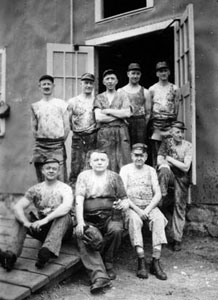 |
|
||
|
Vol. IV No. 19 · 19 January 2001 |
|||
B.U. Bridge is published by the Boston University Office of University Relations.
Now on CD-ROM: real-world lessons in public health
By Hope Green
It wasn't enough just to say that the tap water tasted bad. When residents of Woburn, Mass., suspected that hazardous-waste dumping had caused multiple cases of childhood leukemia in the 1970s, all they had to start with was a hunch.
Before mounting their now-famous 1981 case alleging that W. R. Grace and Beatrice Foods had poisoned their drinking water with carcinogens, the Woburn citizens had to gather piles of evidence from government agencies and learn to interpret their findings.
|
|
|
| Workers at a New England tannery, one of several industries that left behind a legacy of toxic waste in Woburn, Mass. Nevertheless, school sports teams there are still called the Tanners and Tannerettes. Photo courtesy of the Woburn Public Library | |
The environmental detective work that goes into a case like Woburn's is the subject of Investigating Community Environmental Health Problems, a new educational CD-ROM created at BU's School of Public Health. The disc draws lessons from the Woburn story, which inspired Jonathan Harr's bestselling novel A Civil Action and a 1999 Hollywood film starring John Travolta.
Using a combination of text, graphics, audio, video clips, and Web links, the disc provides students with tutorials and describes a simple statistical method to help determine whether hazardous waste is to blame if a community is experiencing above-average rates of disease. It also explores the complex political issues that arise when economic and health interests collide.
"We believe this is one of the best new-media pieces developed within the University to date," says Rob Schadt, SPH manager of educational technology and an adjunct professor at the College of Communication. "It allows students to explore public health in an interdisciplinary way, which is how it is practiced in the real world."
Schadt developed the CD-ROM in collaboration with Richard Clapp, SPH associate professor of environmental health, with $10,000 from BU's Instructional Technology Grant Program. Two decades ago Clapp was the first director of the Massachusetts Department of Public Health's Cancer Registry, which was established to better understand the Woburn situation and others like it.
|
|
|
|
Barbed wire surrounds a federal Superfund site in North Woburn in the late '80s. The site contained tannery waste. Photo by Steven Senne, Woburn Daily Times |
|
In October, copies of the disc were distributed to 450 students at SPH and the School of Medicine. "The faculty have been very impressed," Schadt says. "They are looking for other ways they can use this technology in the courses they teach."
The disc opens with a minidocumentary designed to put the Woburn tragedy in a historical context. Voiceovers and music accompany antique photographs of New England factory hands, which overlap newspaper shots from a later era: abandoned mills and rusting toxic-waste drums. Interactive screens tell how to locate health and environmental data. There are also links to Web sites that aid in this research.
Video segments include television-news interviews with mothers of the cancer-stricken Woburn children and a minister who helped move the legal case forward. Other cameos include Jan Schlichtmann, the crusading attorney who went broke representing the plaintiffs, and experts who convened for a panel discussion two years ago, when the film version of A Civil Action was showing in theaters.
The CD-ROM not only allows different media onto the same platform, Schadt says, "but even more important, it brings different pieces of time together so that the students can interact with it on their time."
It is not always possible for students to study a case history in depth unless they are in an advanced course. The new technology, says Schadt, will help SPH "connect the curriculum to public-health problems in a more effective way," by linking such fields as maternal and child health, epidemiology, and health law in one package.
"I'd like to search out greater funding, maybe a big grant that could get different departments working on this kind of technology," he adds. "Not that they don't already talk to one another, but products like this are fairly novel. There are many issues like tobacco, gun control, and domestic violence that cut across the disciplines. I think the technology is very amenable to the curriculum of the School of Public Health and the way it's organized."
Rob Schadt and Richard Clapp will give a presentation on their CD-ROM at an SPH Public Health Forum, Tuesday, March 27, from 5 to 6 p.m. at the School of Medicine, 715 Albany Street, Room L-112. The forum is free and open to the public. For more information, call 638-4640.
![]()
19
January 2001
Boston University
Office of University Relations

